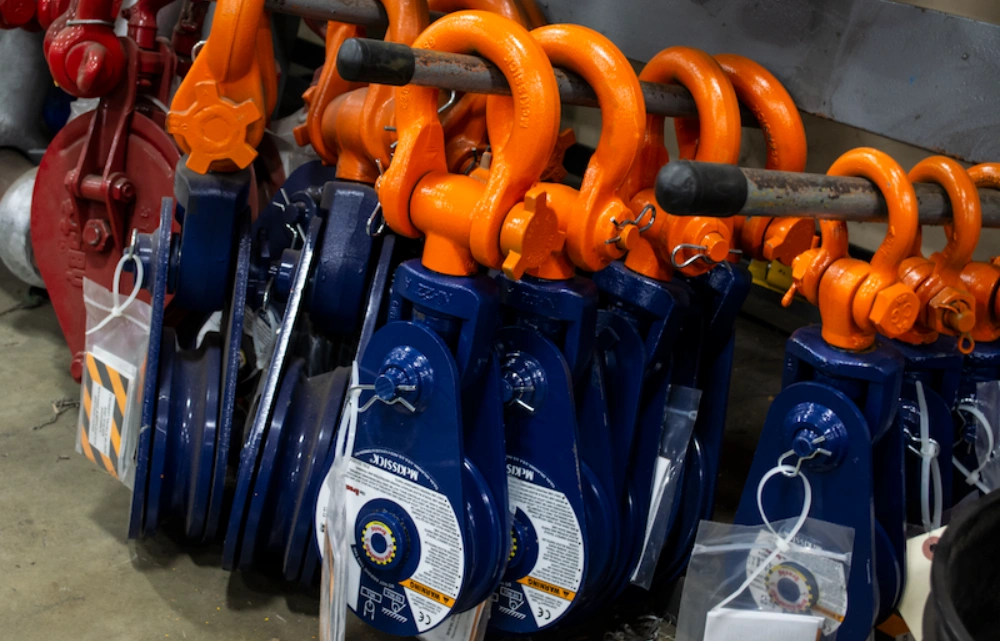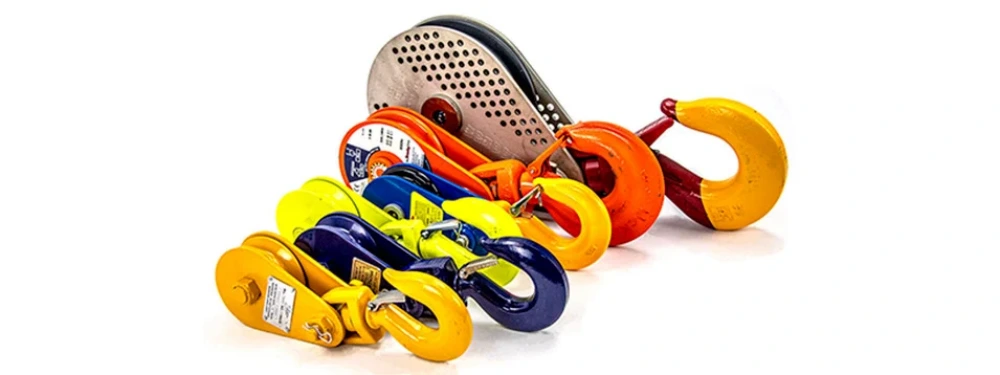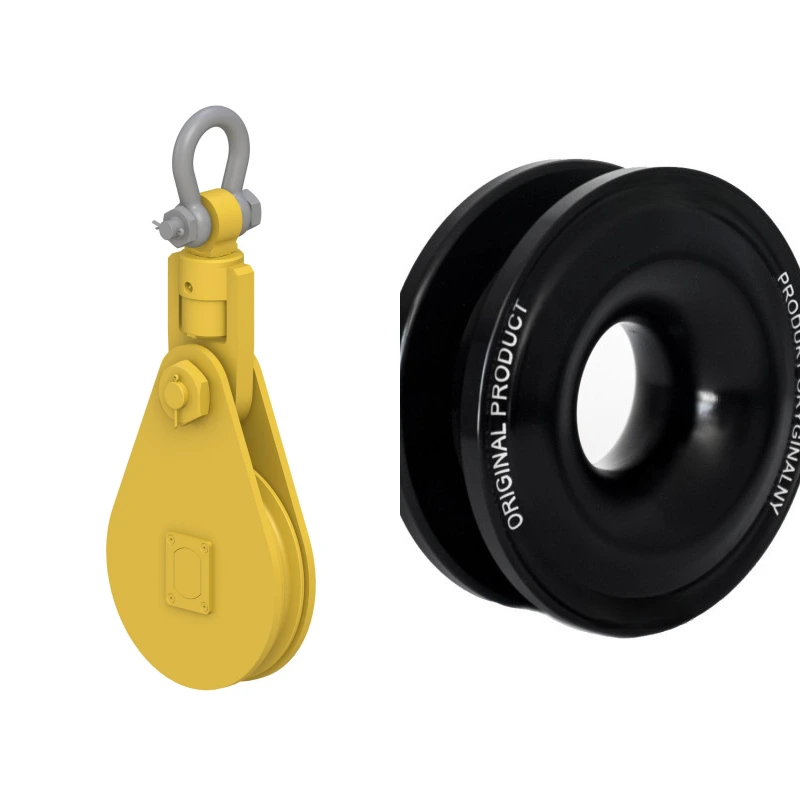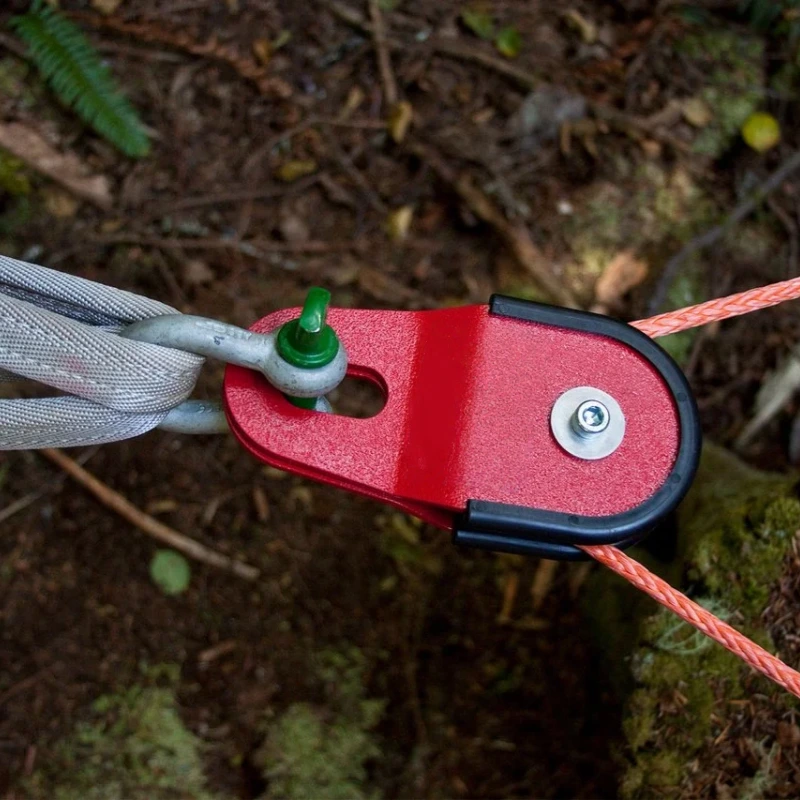You need the right off-road recovery gear to keep your journey safe and efficient. When you compare the recovery ring vs the snatch block, you see that each safety device has unique strengths. Powerful Machinery offers snatch blocks designed for heavy-duty off-road situations.
In overlanding, the load on your gear can change quickly. For example, a vehicle with a gross vehicle weight of 5,500 lbs on a slope or stuck in mud may need to handle loads over 11,000 lbs. The table below shows how off-road conditions affect your recovery needs.
Scenario | Calculation | Result |
|---|---|---|
Vehicle GVW | 5500 lbs | – |
Incline Effect | 5500 lbs x 20 degrees x 1.667% | +1833.7 lbs |
Total Dynamic Load | 5500 lbs + 1833.7 lbs | 7333.7 lbs |
Mired Vehicle Effect | 5500 lbs x 2 (if mired to axles) | 11000 lbs |
Choosing the right gear helps you match your safety device to every off-road challenge.
Key Takeaways
Recovery rings are lightweight and easy to carry, making them ideal for quick recoveries in overlanding situations.
Snatch blocks increase winch pulling power, allowing you to recover heavier vehicles and tackle tough angles effectively.
Choose recovery rings for synthetic winch lines and fast setups; opt for snatch blocks when dealing with heavy loads or complex recovery scenarios.
Both tools enhance safety and efficiency in off-road recovery, but selecting the right one depends on your vehicle’s weight and the recovery challenges you face.
Recovery Ring vs Snatch Block
Main Differences
When you compare the recovery ring vs the snatch block, you notice several important differences in how each tool works and what situations they suit best. Both play a key role in vehicle recovery, but their design and function set them apart.
Feature | Snatch Blocks | Recovery Rings (Winch Rings) |
|---|---|---|
Function | Increases winch pulling power by creating a mechanical advantage | Improves efficiency and safety when recovering vehicles or pulling heavy loads |
Usage | Ideal for changing the direction of pull or doubling the winch’s force | Suitable for use with synthetic rope winches, enhancing pulling force and direction change |
A snatch block uses a pulley system to redirect your winch line and multiply the pulling force. This makes it possible to recover heavier vehicles or tackle tough angles during recovery. You can use a snatch block to double your winch’s power, which is especially helpful in mud, sand, or steep terrain.
A recovery ring, sometimes called a winch ring, is a lightweight device made from high-quality aluminum. You use it with synthetic winch lines to guide the rope and change the direction of pull.
While both tools help with recovery, the recovery ring vs snatch block debate often comes down to the type of winch line you use and the load you need to handle.
Item | Maximum Breaking Strength (MBS) | Rated Load Capacity | Experimental Load |
|---|---|---|---|
Recovery Ring | 79,590 lbs | N/A | N/A |
Snatch Block | N/A | 8 tons (16,000 lbs) | 13 tons |
You will find that a recovery ring is designed for synthetic winch lines and lighter loads. A snatch block, on the other hand, is built for heavy-duty recovery and can handle much higher forces.
Powerful Machinery specializes in snatch blocks that meet the needs of demanding recovery operations, making them a trusted choice for off-road enthusiasts and professionals.
Key Benefits
You gain unique advantages from each tool in the recovery ring vs snatch block comparison. Knowing these benefits helps you choose the right gear for your next adventure.
A snatch block gives you a mechanical advantage. You can double your winch’s pulling power by running the line through the snatch block. This makes it easier to recover vehicles stuck in deep mud, sand, or snow. You can also use multiple snatch blocks to increase your pulling force even more.
Snatch blocks offer versatility. You can use them in many recovery situations, from changing the direction of your pull to handling heavy loads in construction or industrial settings.
Recovery rings are lightweight and easy to carry. You can quickly set them up with synthetic winch lines, making them ideal for fast recoveries when weight and speed matter.
Recovery rings improve efficiency and safety. Their smooth, rounded design reduces friction on synthetic ropes, helping you avoid damage during recovery.
Tip: If you often face extreme conditions or need to recover large vehicles, a snatch block from Powerful Machinery gives you the strength and reliability you need. If you want a lightweight solution for synthetic ropes, a recovery ring is a smart choice.
When you look at the recovery ring vs snatch block, think about your winch line type, the weight of your vehicle, and the recovery challenges you expect to face. Both tools have a place in your recovery kit, but choosing the right one can make your next recovery safer and more efficient.
What Is a Recovery Ring?

Features
A recovery ring is a modern tool for off-road recovery. You use it with synthetic winch lines and soft shackles. The ring helps you change the direction of your pull and makes recovery safer. Most recovery rings use aircraft-grade aluminum. This material gives you strength without adding extra weight.
Here is a table showing common features of recovery rings:
Feature | Description |
|---|---|
Material | T6 6061 Aircraft Grade Aluminum |
Lightweight Design | About 1/3 the weight of traditional snatch blocks |
High Strength | Breaking strength up to 45,000 lbs |
Durable Construction | Hard-anodized coating resists wear and scratching |
Smooth, Rounded Design | Prevents pinch points and reduces friction |
Beveled Inner Lip | Allows clearance for synthetic rope |
Maintenance-Free Operation | No bearings required |
Color | Often red anodized finish |
Storage Bag | Quick cinch bag for easy transport |
You can handle and store recovery rings easily because of their lightweight design. The smooth surface protects your synthetic rope from damage. You do not need to lubricate or maintain moving parts.
Pros
Recovery rings offer several advantages for off-road recovery. You get a tool that is easy to use and strong enough for tough jobs.
You can carry recovery rings without adding much weight to your gear.
The smooth, rounded edges protect your synthetic winch line from cuts and wear.
You do not need to worry about bearings or moving parts. This makes the operation simple and maintenance-free.
The high breaking strength lets you recover large vehicles safely.
The anodized coating reduces friction and prevents scratching.
You can use recovery rings with soft shackles for versatile setups.
Tip: Recovery rings work well for quick recoveries when you need speed and efficiency. Their lightweight design makes them perfect for overlanding trips where every pound counts.
Cons
Recovery rings have some limitations you should consider before choosing them for your recovery kit.
You can only use recovery rings with synthetic winch lines and soft shackles.
The load capacity may be lower than heavy-duty snatch blocks.
Recovery rings do not work with steel cables.
You may need to check the ring for wear after repeated use in harsh conditions.
You should match your recovery ring to your winch line and vehicle weight. For heavy loads or steel cables, you may need a snatch block instead. Recovery rings give you a lightweight, efficient option for most overlanding recovery scenarios.
What Is a Snatch Block?

Features
You use a snatch block to boost your winch’s power and make tough recoveries easier. This tool works by redirecting your winch line, which doubles the pulling power and reduces strain on your equipment.
You can change the direction of your pull, making it possible to recover vehicles from tricky spots. Snatch blocks come in different designs, each with features that help you handle heavy loads and complex recovery tasks.
Design Element | Description |
|---|---|
Cheek Plate | Removable plate lets you insert rope easily without removing the load or fittings. |
Power Enhancement | Increases winch power, often doubling its effectiveness. |
Direction Change | Allows you to change rope direction during winching. |
Variety of Applications | Used in many industries, especially with electrical winches for pulling loads. |
Types Available | Multiple designs and sizes to match your load requirements. |
Snatch blocks use durable materials like forged steel and alloy to withstand demanding conditions. You can rely on their construction for safe and efficient recoveries.
Powerful Machinery Snatch Block Types

Powerful Machinery offers several snatch block options to fit your recovery needs. Each type has unique features for different situations.
Type of Snatch Block | Distinguishing Characteristics |
|---|---|
Hook Snatch Block | Features a hook for quick attachment, perfect for portable rigging. |
Shackle Snatch Block | Comes with a shackle for secure connections, ideal for heavy-duty and long-term use. |
Tailboard Snatch Block | Designed for mounting on flat surfaces, used when you need the block fixed in one spot. |
Swivel Snatch Block | Has a swivel mechanism for flexibility and prevents rope twisting during lifting. |
You can choose the snatch block that matches your winch line, load capacity, and recovery scenario. Powerful Machinery snatch blocks meet strict safety standards and offer reliable performance.
Pros
Snatch blocks give you several advantages in off-road recovery gear setups. You can use them to:
Increase your winch’s power and handle heavier loads.
Change the direction of your pull to avoid obstacles.
Reduce strain on your winch and cable, improving safety.
Use smaller winches for bigger jobs by boosting their capacity.
Rely on heavy-duty steel construction for durability.
Benefit from anti-disengagement designs for secure connections.
Trust compliance with federal safety standards.
Benefit | Description |
|---|---|
Greater Load Capacity | Enables smaller winches to manage heavier towing jobs. |
Directional Flexibility | Allows for easy redirection of pulls around obstacles, enhancing maneuverability. |
Enhanced Safety | Reduces strain on equipment and minimizes the risk of cable snapping, improving overall safety. |
You can see why professional recovery teams choose snatch blocks for demanding tasks.
Cons
You need to inspect your snatch block regularly to keep it working safely. Check for cracks, wear, and proper lubrication. Make sure all markings are clear and permanent. Look at the side plates, straps, and pinhole areas for any signs of damage.
Grease the pins and bushings to maintain smooth operation. Always use snatch blocks within their rated capacity to avoid accidents.
Note: You should keep original certificates and test reports for your snatch block. This ensures you meet safety standards and can trust your gear in critical situations.
Recovery Ring vs Snatch Block Comparison
Weight & Portability
When you build your off-road recovery kit, weight and portability matter. You want gear that fits easily in your vehicle and does not slow you down. Recovery rings stand out for their lightweight design.
Most recovery rings weigh about 1 to 1.5 pounds. You can slip one into your pocket or a small bag. This makes them perfect for overlanding trips where every pound counts.
Snatch blocks, on the other hand, weigh more. A typical snatch block comes in at around 3.7 pounds. You may find it bulkier in your kit, especially if you carry more than one. The extra weight means you need to plan your storage space carefully.
Product Type | Weight | Portability Description |
|---|---|---|
Recovery Ring | 1-1.5 lbs | Fits in a pocket, very portable |
Snatch Block | 3.7 lbs | Heavier, less portable than recovery rings |
Tip: If you want to keep your off-road recovery gear light and easy to carry, choose a recovery ring. For heavy-duty pulling power, a snatch block is worth the extra weight.
Ease of Use
You want recovery gear that works fast when you need it most. Recovery rings offer simple operation. You thread your synthetic winch line through the ring, attach a soft shackle, and you are ready to recover your vehicle. There are no moving parts, so you do not need to worry about jams or maintenance in the field.
Snatch blocks require a bit more setup. You open the cheek plate, insert your winch line, and close it securely. You may need to grease the moving parts after heavy use. The extra steps add time, but you gain more pulling power for tough recoveries.
Recovery rings: Quick setup, minimal steps, no moving parts.
Snatch blocks: More steps, need for regular checks, but offer more pulling options.
Note: For fast recoveries on the trail, a recovery ring saves time. For complex recoveries or when you need to double your winch’s pulling power, a snatch block is the right tool.
Compatibility
You need recovery gear that matches your winch line and vehicle type. Recovery rings work best with synthetic winch lines and soft shackles. They do not support steel cables. If your kit uses synthetic rope, a recovery ring fits perfectly.
Snatch blocks offer more flexibility. You can use them with both synthetic and steel winch lines. They work for a wide range of vehicles, including trucks, tractors, ATVs, and UTVs. This makes snatch blocks a versatile choice for mixed fleets or when you want one piece of equipment for different vehicles.
Feature | Details |
|---|---|
Winch Line Compatibility | Works with both synthetic and steel lines |
Vehicle Types | Effective for trucks, tractors, ATVs, UTVs |
Callout: If you use steel winch lines or recover different types of vehicles, add a snatch block to your off road recovery kit for maximum compatibility.
Durability & Safety
You want recovery gear that keeps you and your vehicle safe. Recovery rings use strong aluminum, like 7075 or T6 6061, and have no moving parts. This design means mud, sand, or debris cannot jam the ring.
You get a working load limit of up to 22,000 pounds. Many users consider recovery rings safer than steel snatch blocks because there is less risk of failure in harsh conditions.
Snatch blocks vary in quality. High-end snatch blocks, such as those from Powerful Machinery, use forged steel and meet strict safety standards. You get reliable pulling power and strong construction.
Some snatch blocks may have higher friction or need more maintenance, but top models deliver excellent performance and safety.
Safety Tip: Always inspect your recovery gear before use. Choose certified snatch blocks and high-quality recovery rings to protect yourself and your equipment during off-road recoveries.
Cost
Cost plays a big role when you build your recovery kit. Recovery rings usually cost less than heavy-duty snatch blocks. You get a lightweight, strong tool at a lower price. This makes recovery rings a good choice if you want affordable winch accessories for your kit.
Snatch blocks cost more because of their complex design and heavy-duty materials. You pay extra for higher pulling power and versatility. If you need to recover large vehicles or handle tough off-road situations, the investment in a quality snatch block pays off in safety and performance.
Recovery rings: Lower cost, great for basic recoveries and lightweight kits.
Snatch blocks: Higher cost, ideal for demanding recoveries and mixed vehicle fleets.
Note: Balance your budget with your recovery needs. For most overlanding recovery gear setups, a mix of both tools gives you the best value and safety.
When to Use Each?
Best for Recovery Rings
You want to choose a recovery ring when you need lightweight, fast, and efficient off-road recovery. Recovery rings work best with synthetic winch lines and soft shackles. You can use them in many overlanding situations where you need to move quickly or keep your gear light.
Overlanding experts recommend recovery rings for:
Overlanding trips where you need to save space and weight in your vehicle
Rock crawling, where you need to change the direction of your winch line without adding bulk
Deep, slippery terrains that require quick winch recovery setups
Assisting vehicles stuck on the roadside, especially when you use a kinetic recovery strap with a synthetic winch line
Recovery rings give you a simple way to guide your winch line and protect your rope. You do not need to worry about moving parts or heavy equipment. This makes them a smart choice for solo travelers or anyone who values speed and efficiency in off-road recovery.
Best for Snatch Blocks
You should use a snatch block when you need maximum pulling power and versatility in your off-road recovery gear. Snatch blocks work with both synthetic and steel winch lines. They help you double or even triple your winch’s pulling force. Choose a snatch block if you:
Recover heavy vehicles like trucks or SUVs stuck in mud, sand, or snow
Need to change the direction of your winch line around obstacles or trees
Want to reduce strain on your winch and cable for better safety
Use a kinetic recovery strap in combination with a winch for complex recoveries
Powerful Machinery snatch blocks excel in demanding off-road situations. Their strong construction and certified safety features make them ideal for professional recovery teams and serious overlanders.
Real-World Scenarios
You can see the value of each tool in real-world off-road recovery. For example:
You use a recovery ring to help a friend’s vehicle get unstuck on a rocky trail. The lightweight ring lets you set up your winch recovery fast and get back on the road.
You face a deep mud pit with your vehicle. A Powerful Machinery snatch block lets you double your winch’s pulling power, making it possible to pull your vehicle free.
You need to pull a fallen tree off the road. A snatch block allows you to redirect your winch line at a 90-degree angle, clearing the path safely.
In a group overlanding trip, you combine a kinetic recovery strap with a winch and snatch block to recover multiple vehicles from tough spots.
Tip: Always match your recovery gear to your vehicle, winch line, and the specific off-road challenge. This ensures safety and success on every adventure.
Choosing Off-Road Recovery Gear
Factors to Consider
You want to choose the right off-road recovery gear for your vehicle and adventure. Start by thinking about the weight of your vehicle and the type of winch you use. Heavier vehicles need stronger recovery gear.
You should check if your gear matches your winch line, whether it is synthetic or steel. Reliable gear keeps you safe during off-road recovery.
Look for gear with certifications and warranties. Brands like Powerful Machinery test their snatch blocks to meet strict safety standards. Certified gear means you can trust it in tough road conditions. High-quality gear lasts longer and performs well under stress. Compromised gear can put you and your vehicle at risk.
Factor | Why It Matters |
|---|---|
Vehicle Weight | Heavier vehicles need stronger gear |
Winch Line Type | Synthetic or steel lines require matching gear |
Certifications | Certified gear ensures safety |
Warranty | Shows confidence in durability |
Terrain | Rocky, muddy, or sandy roads affect gear choice |
Tip: Always check your gear before every recovery. Make sure it is rated for your vehicle and winch.
Tips for Selection
You can make smart choices when building your off-road recovery kits. Match your gear to your vehicle’s size and weight. If you travel solo, pack lightweight gear like recovery rings.
For group trips or technical trails, bring heavy-duty gear such as snatch blocks. Assess the terrain you plan to cross. Simple roads need basic gear, while rough trails require advanced recovery gear.
Consider your training level. Proper training helps you use gear safely and avoid injury. Plan for future training to improve your recovery skills. Choose gear with a lifetime replacement warranty for peace of mind. Reliable gear protects your vehicle and keeps you moving on the road.
Check your vehicle recovery gear for compatibility with your winch and vehicle.
Select a gear that matches your vehicle’s weight and the demands of off-road recovery.
Prepare for different road conditions by packing versatile gear.
Look for gear with certifications and warranties for added safety.
Upgrade your gear as your recovery experience grows.
Callout: Overlanding recovery gear from Powerful Machinery offers certified reliability for every road adventure. Their snatch blocks and vehicle recovery winches help you tackle tough recovery situations with confidence.
Conclusion
When you choose off-road recovery gear, you need to match your gear to your recovery needs. The table below shows how recovery rings and snatch blocks compare for off-road recovery gear:
Feature | Recovery Ring | Snatch Block |
|---|---|---|
Weight & Size | Light, compact gear | Heavy-duty, larger gear |
Strength | Great for most gear | Best for extreme gear loads |
Maintenance | No gear upkeep | Needs gear cleaning |
Compatibility | Synthetic gear only | All winch gear types |
Best For | Every day gear use | Heavy-duty gear recovery |
You should consider these points when selecting certified, high-performance snatch blocks for your off-road recovery gear:
The type of winch line in your gear setup
The weight of vehicles that your gear must recover
The specific recovery needs your gear must meet
A snatch block is a pulley with a side plate that opens, making it easy to add to your off-road recovery gear without threading the cable.
You can trust Powerful Machinery snatch blocks for reliable, certified off-road recovery gear. Explore their full range to find the right gear for safe and efficient recoveries.
FAQ
What is the main difference between a recovery ring and a snatch block?
A recovery ring works best with synthetic winch lines and offers lightweight, quick setups. A snatch block handles heavier loads and works with both steel and synthetic lines. You should choose based on your winch line and recovery needs.
Can you use a snatch block with any winch line?
Yes, you can use a snatch block with both steel and synthetic winch lines. This makes snatch blocks a versatile choice for many recovery situations. Always check the compatibility of your gear before starting a recovery.
How do you maintain a snatch block for safe use?
You should inspect your snatch block before each use. Look for cracks, wear, or damage. Lubricate moving parts as needed. Keep all markings visible. Regular maintenance ensures your gear stays safe and reliable.
When should you choose Powerful Machinery snatch blocks?
You should choose Powerful Machinery snatch blocks when you need certified, heavy-duty recovery gear. Their products meet strict safety standards and offer reliable performance for demanding off-road recoveries.
Are recovery rings safe for heavy vehicles?
Recovery rings are safe for most overlanding vehicles when used with synthetic winch lines. Always check the rated breaking strength of your ring. For extremely heavy vehicles, consider using a snatch block for added safety.


